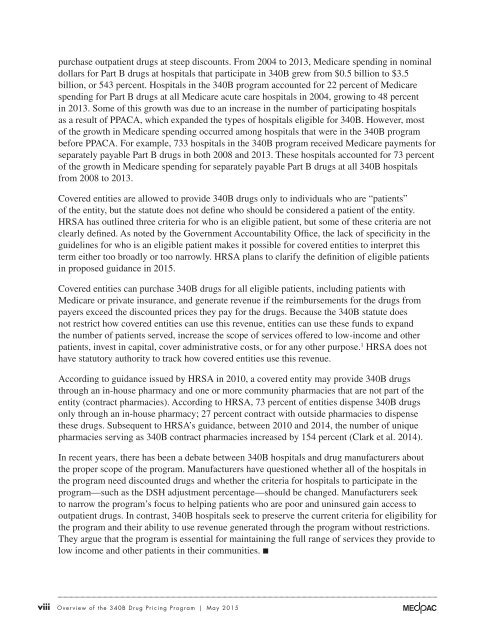Overview of the 340B Drug Pricing Program
1Mmfbin
1Mmfbin
Create successful ePaper yourself
Turn your PDF publications into a flip-book with our unique Google optimized e-Paper software.
purchase outpatient drugs at steep discounts. From 2004 to 2013, Medicare spending in nominal<br />
dollars for Part B drugs at hospitals that participate in <strong>340B</strong> grew from $0.5 billion to $3.5<br />
billion, or 543 percent. Hospitals in <strong>the</strong> <strong>340B</strong> program accounted for 22 percent <strong>of</strong> Medicare<br />
spending for Part B drugs at all Medicare acute care hospitals in 2004, growing to 48 percent<br />
in 2013. Some <strong>of</strong> this growth was due to an increase in <strong>the</strong> number <strong>of</strong> participating hospitals<br />
as a result <strong>of</strong> PPACA, which expanded <strong>the</strong> types <strong>of</strong> hospitals eligible for <strong>340B</strong>. However, most<br />
<strong>of</strong> <strong>the</strong> growth in Medicare spending occurred among hospitals that were in <strong>the</strong> <strong>340B</strong> program<br />
before PPACA. For example, 733 hospitals in <strong>the</strong> <strong>340B</strong> program received Medicare payments for<br />
separately payable Part B drugs in both 2008 and 2013. These hospitals accounted for 73 percent<br />
<strong>of</strong> <strong>the</strong> growth in Medicare spending for separately payable Part B drugs at all <strong>340B</strong> hospitals<br />
from 2008 to 2013.<br />
Covered entities are allowed to provide <strong>340B</strong> drugs only to individuals who are “patients”<br />
<strong>of</strong> <strong>the</strong> entity, but <strong>the</strong> statute does not define who should be considered a patient <strong>of</strong> <strong>the</strong> entity.<br />
HRSA has outlined three criteria for who is an eligible patient, but some <strong>of</strong> <strong>the</strong>se criteria are not<br />
clearly defined. As noted by <strong>the</strong> Government Accountability Office, <strong>the</strong> lack <strong>of</strong> specificity in <strong>the</strong><br />
guidelines for who is an eligible patient makes it possible for covered entities to interpret this<br />
term ei<strong>the</strong>r too broadly or too narrowly. HRSA plans to clarify <strong>the</strong> definition <strong>of</strong> eligible patients<br />
in proposed guidance in 2015.<br />
Covered entities can purchase <strong>340B</strong> drugs for all eligible patients, including patients with<br />
Medicare or private insurance, and generate revenue if <strong>the</strong> reimbursements for <strong>the</strong> drugs from<br />
payers exceed <strong>the</strong> discounted prices <strong>the</strong>y pay for <strong>the</strong> drugs. Because <strong>the</strong> <strong>340B</strong> statute does<br />
not restrict how covered entities can use this revenue, entities can use <strong>the</strong>se funds to expand<br />
<strong>the</strong> number <strong>of</strong> patients served, increase <strong>the</strong> scope <strong>of</strong> services <strong>of</strong>fered to low-income and o<strong>the</strong>r<br />
patients, invest in capital, cover administrative costs, or for any o<strong>the</strong>r purpose. 1 HRSA does not<br />
have statutory authority to track how covered entities use this revenue.<br />
According to guidance issued by HRSA in 2010, a covered entity may provide <strong>340B</strong> drugs<br />
through an in-house pharmacy and one or more community pharmacies that are not part <strong>of</strong> <strong>the</strong><br />
entity (contract pharmacies). According to HRSA, 73 percent <strong>of</strong> entities dispense <strong>340B</strong> drugs<br />
only through an in-house pharmacy; 27 percent contract with outside pharmacies to dispense<br />
<strong>the</strong>se drugs. Subsequent to HRSA’s guidance, between 2010 and 2014, <strong>the</strong> number <strong>of</strong> unique<br />
pharmacies serving as <strong>340B</strong> contract pharmacies increased by 154 percent (Clark et al. 2014).<br />
In recent years, <strong>the</strong>re has been a debate between <strong>340B</strong> hospitals and drug manufacturers about<br />
<strong>the</strong> proper scope <strong>of</strong> <strong>the</strong> program. Manufacturers have questioned whe<strong>the</strong>r all <strong>of</strong> <strong>the</strong> hospitals in<br />
<strong>the</strong> program need discounted drugs and whe<strong>the</strong>r <strong>the</strong> criteria for hospitals to participate in <strong>the</strong><br />
program—such as <strong>the</strong> DSH adjustment percentage—should be changed. Manufacturers seek<br />
to narrow <strong>the</strong> program’s focus to helping patients who are poor and uninsured gain access to<br />
outpatient drugs. In contrast, <strong>340B</strong> hospitals seek to preserve <strong>the</strong> current criteria for eligibility for<br />
<strong>the</strong> program and <strong>the</strong>ir ability to use revenue generated through <strong>the</strong> program without restrictions.<br />
They argue that <strong>the</strong> program is essential for maintaining <strong>the</strong> full range <strong>of</strong> services <strong>the</strong>y provide to<br />
low income and o<strong>the</strong>r patients in <strong>the</strong>ir communities. ■<br />
viii <strong>Overview</strong> <strong>of</strong> <strong>the</strong> <strong>340B</strong> <strong>Drug</strong> <strong>Pricing</strong> <strong>Program</strong> | May 2015


